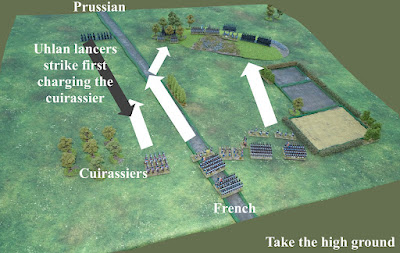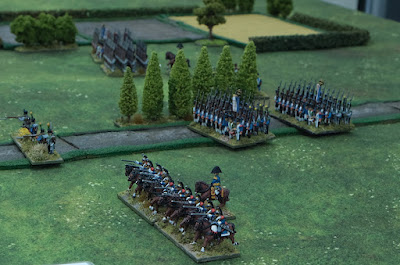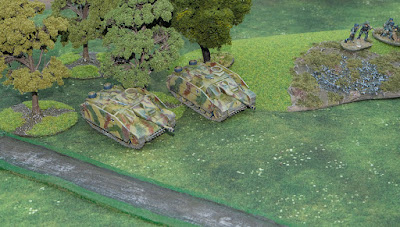Four rule sets.
The table was set with a view to working through the same scenario four times, each time with a different set of rules, just to highlight the main points of difference, an interesting exercise for its own sake I thought, but I was wrong, as it just seemingly echoed the negative aspects of having a richness of rule sets to choose from.
This is something that particularly invades my own wargaming space because I also play a wide variety of boardgames, each with their own rule systems and the collective effect of learning and constantly re-learning each of these systems means that often a single set are not played particularly well ….. the old saying of ‘Jack of all trades, master of none’ springs to mind.
I refer to four figure sets, but there are a dozen to choose from, sitting there noisily on the shelf - too much goodness!
Anyway, in the first game, I quickly found myself floundering on the skirmisher rules, I should know them better and then as other things cropped up I found the rules increasingly in my hands as I tried to find ‘that sentence’ that I was sure existed somewhere …… or was it in another rule set!
Anyway, it must have been a mood thing, because I just just gave up, re-set and turned to my own home brew rules, ‘Eagles at Quatre Bras’ and had an enjoyable game … or two!
This is not to say that I view my rules as being any better than the others, in fact I would state categorically that they are certainly not. They fall more into the entertainment bracket than simulation, but it is almost certainly the intimate knowledge of the rules and the inclusion of favoured mechanics that makes them a comfortable pick-up.
What it has done in my mind is to reinforce the need to get rid of most of my figure rule sets and to continue driving down the boardgame collection to a smaller hub of games that run off ‘series’ style rulebooks.
The rest of this post is just a bit of a ramble / navel gazing about the ‘trial of four games’ and the continued development of Eagles at Quatre Bras. Please use the ‘read more’ tab if this sort of thing interests you.
The idea behind the four games was to simply highlight differences in the outcome of common areas such as Command & Control, the manoeuvrability of force and the individual resilience of various unit types on the battlefield.
The game area was to be limited as were the orders of battle, an aspect of wargaming, often by necessity, that I know interests many of the readers that follow this blog.
The table was 48 inches wide and 42 inches deep for a game using the plastic Warlord Games Epic figures, which are just under 15mm.
The forces per side were equal in number (4 infantry, 1 artillery, 1 cavalry), but slightly different in composition and were typical of the Neil Thomas style armies.
Everything on the French side was regular and their cavalry were cuirassier. On the Prussian side, they had a regiment of 2 musketeer and 1 fusilier battalions, supported by 1 landwehr infantry battalion - all classed regular, but their cavalry were Uhlan lancers, classed as inferior (referred to as Limited in my rules).
Three of the rulesets that I planned to use are mainstream commercial systems, the fourth being my own home brew set. I am deliberately not naming the rules concerned (except my own of course) or the set that I got hung up on, because I am taking a swipe at them and that is not what this blog is about.
The Prussian fusiliers, which were placed in the woods at the hill, had the attribute of ‘light’ and so they could deploy the entire battalion as skirmishers amongst the trees.
The French battalions were all line units and they could throw out the flank companies to give a skirmish screen. Some napoleonic sets have different rules for these two types of skirmishing bodies (screen and battalion) and I think this is where I first became unstuck in the first game.
Anyway, after retiring to a chair to read the appropriate rule sections for a third time, I gave up. My constant companion, a pinching bad back, has flared up this week and was not helping my patience and so with not a little frustration, the game was re-set and my own rules dragged out. These of course had not been played for a while, but I quickly pushed through a rusty start.
My own rules are not particularly straight forward, I have always felt that to a new player they would have a certain level of awkwardness, but familiarity is of course everything and I could without doubt, be served equally well or even better by taking one of the commercial sets as a ‘go to’ system and abandoning all others, but there we are.
EaQB rules have changed from their first format (which I think I liked better) and have been melded with the ACW rules. These have a different heritage, but I wanted a standard core to a horse and musket set, with the differences of each mostly restricted to the Quick Reference card to ease administration.
This means that for every change I put into Eagles at Quatre Bras, I need to go back to TF-ON, to see whether they too need the same modification. How skirmishers operate being a case in point.
They are written in an order that accords with the sequence of play, so start at the page that deals with special events and then work through the rest of the pages, covering Command & Control through to Retreat checks, which will get you to the end of the player turn.
One of the downsides in the rules that becomes apparent in play is the number of dice rolls made. This is because several aspects of the rules require a unit to make Ability Checks before they do something significant such as formation change or in response to taking casualties. I suppose these checks are in truth serving a wider range of activity that would also normally include morale checks.
The more casualties and disruption that a unit suffers, the harder these checks are to pass. There comes a tipping point in which the unit is less capable on the attack and then even on defence they become somewhat creaky, until they reach a point of leaving the battlefield.
I have looked for ways of reducing the number of dice rolls and have successfully streamlined one part of the rules in particular, but when going too far, the feel of the game becomes too generic.
As the game progresses and units start to be subject to the rigours and strains of contact through loss and disorder, these rolls do become more important and also put an emphasis on having a fresh unit or two in reserve.
The number of dice rolls is perhaps more acutely felt in solo play. In face to face play, the ‘burden’ of dice rolling and adding up modifiers etc is a shared experience and so the issue is less noticeable.
So what of our games? The first was conducted with the Epic figures and visually the scale offers a birds eye view and is easier to separate into different areas of battle or at least gives the sense of doing that and putting the player in the boots of the overall commander. This is somewhat assisted by the rules which gives the player a personal role on the battlefield as Divisional Commander.
Something did crop up that I need to research and the observations of those in the know here would be helpful on this. Close combat is decisive, there is just one round of it and a loser will always be established and forced to fall back.
My question concerns lancers. They do get a combat bonus on the charge for the lance, but should that bonus re-occur in later contacts i.e. by its nature, is the lance spent when first used, to be left behind in the body of a poor corpse in their undignified repose?
The rules do not allow charges on consecutive turns and there are rules for blown horses, so there would be a period of rest between charges. Some rules only allow the lance bonus in the first round of melee, but having just one round of combat doesn’t offer such opportunity.
Perhaps if the lancers are victorious they could be considered to have retrieved their lances, but at this point I don’t know whether that is realistic or practical or even whether the battalion carried a supply of lance with them that would allow immediate re-supply or whether in truth, most lancers did not lose their lance in the first instance. Some research needed for sure.
 |
| The French push the fusiliers out of the woods |
Anyway, the cuirassiers were caught out of effective formation and badly mauled. Overall though, as one might expect with equal numbers per side, with one side holding a defensive position, the assault stalled.
I was able to clear away and set up a 28mm battlefield within the same parameters as the smaller one, except Austrians replace the Prussians. These are my experimental units as I am not yet resolved as to which scale to invest painting time in, so they are unpainted and temporary glued to bases while both ultimate base size and rules are decided upon.
I have been using the summer to put the plastic 28mm multi part figures together, as I can do this outside due to me having a bit of an aversion to the glue. However the UK weather, like for the rest of the world has been bizarre, with loads of rain in July, mostly falling on my house! Yesterday I only managed to get six Austrian Grenadiers done, today, nothing will get done.
Each 28mm base is 80mm as opposed to the Epic base of 60mm, so when a unit is in line ( 2 bases ), the 28mm occupy 40mm more frontage in total than the Epic do.
Here, that seemed to matter a bit, but not as much as one might have thought. I even kept the same sized hill. The only real compromise was that to help with the fitting, the gun batteries were dropped to one model instead of my preferred two.
In this game, with the same rules, the French assault was not only thrown back, but the Austrians went onto the counter-attack. I played it out to its conclusion with the French doing a fighting retreat to get off the table.
I used the same measurements as I had used for the 15mm game, but even though the base sizes are not hugely different, the figure sizes and mass are very different and visually it just didn’t look or feel right.
I will re-run this on a wider table and return to the 28mm measurements given in the rules, which essentially have a 50% uplift. This does have the effect of bringing the forces into contact faster.
What I did like was that there still felt to be different locations on the battlefield, the hill, the woods and the cavalry wing and that this fell from a force of just 6 units per side.
I would like to move this to a better sense of ‘small battle’ size with say 10 - 12 elements per side, that would do me fine, I don’t want to be collecting and having to paint up 20 odd battalions per side, for either 28mm or Epic for that matter.
I do appreciate the beauty of the individual figure.
A force of 12 units could be administered as say three brigades, which fits in with the rules, which at the command level has brigade commanders and a divisional commander.
Anyway, as an exercise, it was still useful even though I didn’t compare multiple rulesets (though perhaps in a sense I did when abandoning the commercial sets).
I was left thinking about that French assault up the small hill. In both games it was thrown back, as would be fully expected of a force without superiority attacking a defensive position that was pretty much fresh and I would expect the commercial sets to likely give a similar result, barring extreme dice rolls.
This made me wonder about just how necessary, bigger, deeper and more thorough rule systems are compared to a simpler fun system - if both come up with a similar result and the result / narrative feels right, then more power to the fun set.
The two test games raised a few points for me to consider revising, one being lancers, so there is still some way to go on these.
Other mods that cropped up were;
On forced fallback after taking casualties, should terrain penalties be ignored.
Look at cavalry pursuit.
Look at movement penalties for units that move outside front and rear arcs.
Three paragraphs contained ambiguity and needed a tidy up.
Finally, before packing away the Epic table, I put a few WWII 12mm units on the battlefield and ran some Rapid Fire exercises.
Then likewise did the same after the 28mm game with some 1/72 models.
All in, it seems I got more gaming done in a couple of hours than would likely have been the case by sticking with the first set.
Again, this is not so much about wanting to get more involved in my own set, but being more certain about choosing any one set and sticking with it.
If you have stayed with this navel gazing ramble - thanks, some of this is bound to feed into future decluttering / progress posts.
Resource Section.
My sister webspace ‘COMMANDERS’ is being re-configured to showcase various figure and boardgame systems that I am enjoying and gives a flavour of where current projects are up to. Link.








